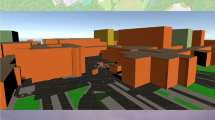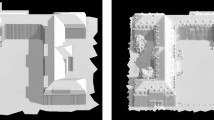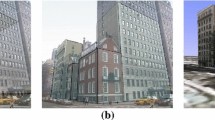Abstract
Recent days, real-time 3D visualization is widely required for pervasive games. Despite the use of level-of-detail techniques, the real-time rendering of massive terrain datasets exceeds the capability of today’s graphics hardware. So, to visualize the realistic terrain on various devices, the oversimplification of datasets is required. The oversimplification reduces computing and data transmission time. Owing to the oversimplification, however, artifacts such as geo-popping may appear in rugged regions, particularly when low level-of-detail is involved. Geo-popping is undesirable visual effect that occurs when the transition of a 3D object to a different level of detail is performed. To reduce such artifacts, we propose a novel mesh simplification method by concentrating on the vertices of regular grids in a rugged area using the concept of attraction and elastic forces. Each sampling point of the terrain data may pull on adjacent vertices with an attraction force that corresponds to its predicted surface roughness. However, strong attraction forces may cause a geometrical twisting or overlapping problems. To solve these problems, we apply an elastic force to a vertex and its neighbors. This makes each vertex push its neighbors away when they are too close. Computing the displacement of each vertex using attraction and elastic forces provides a fine-mesh terrain representation in rough areas, and a coarse-mesh representation in smooth areas. As a result, our method efficiently visualizes more accurate terrain scenes by reducing the number of geo-popping that mainly appear in rugged areas.














Similar content being viewed by others
References
Alperin RC (1987) Heron’s area formula. Coll Math J 18:137–138
Asirvatham A, Hoppe H (2005) Terrain rendering using GPU-based geometry clipmaps. GPU gems 2:27–46
Blythe D (2006) The direct3d 10 system. ACM Trans on Graph (TOG) 25:724–734
Chang S-M, Chang H-H, Yen S-H, Shih TK (2013) Panoramic human structure maintenance based on invariant features of video frames. Human-centric Comput Inf Scie 3:14. doi:10.1186/2192-1962-3-14
Cho H, Choi M (2014) Personal Mobile Album/Diary Application Development. Journal of Convergence 5:
Christou G (2013) A comparison between experienced and inexperienced video game players’ perceptions. Human-centric Comput Inf Sci 3:15. doi:10.1186/2192-1962-3-15
Cignoni P, Ganovelli F, Gobbetti E, et al. (2003) Planet-sized batched dynamic adaptive meshes (P-BDAM). Proc. 14th IEEE Visualization 2003 (VIS’03). IEEE, p 20
Cignoni P, Puppo E, Scopigno R (1997) Representation and visualization of terrain surfaces at variable resolution. Vis Comput 13:199–217
Clasen M, Hege H-C (2006) Terrain rendering using spherical clipmaps. Proc. 8th Joint Eurographics/IEEE VGTC conference on Visualization. Eurographics Association, pp 91–98
Dachsbacher C, Stamminger M (2004) Rendering procedural terrain by geometry image warping. Proc. 15th Eurographics conference on Rendering Techniques. Eurographics Association, pp 103–110
Dick C, Schneider J, Westermann R (2009) Efficient Geometry Compression for GPU-based Decoding in Realtime Terrain Rendering. Computer Graphics Forum. Wiley Online Library, pp 67–83
Duchaineau M, Wolinsky M, Sigeti DE, et al. (1997) ROAMing terrain: real-time optimally adapting meshes. Proc. 8th Conference on Visualization’97. IEEE, pp 81–88
Eun-Seok LEE, Byeong-Seok S (2011) Geometry splitting: an acceleration technique of quadtree-based terrain rendering using GPU. IEICE Trans on Inf Sys 94:137–145
Evans W, Kirkpatrick D, Townsend G (2001) Right-triangulated irregular networks. Algorithmica 30:264–286
Garland M, Heckbert PS (1995) Fast polygonal approximation of terrains and height fields. School of Computer Science, Carnegie Mellon University
Goldgof DB, Huang TS, Lee H (1989) A curvature-based approach to terrain recognition. IEEE Trans Patt Anal Machine Intell 11:1213–1217. doi:10.1109/34.42859
Gu X, Gortler SJ, Hoppe H (2002) Geometry images. ACM Transactions on Graphics (TOG). ACM, pp 355–361
Gunn SR (1998) Edge detection error in the discrete laplacian of gaussian. ICIP 2:515–519
Heidrich W, Slusallek P, Seidel H-P (1998) Real-time generation of continuous levels of detail for height fields. Proc. WSCG’98. pp 315–322
Hoppe H (1998) Smooth view-dependent level-of-detail control and its application to terrain rendering. Proc. Visualization’98. IEEE, pp 35–42
Hu L, Sander PV, Hoppe H (2009) Parallel view-dependent refinement of progressive meshes. Proc. 2009 symposium on Interactive 3D graphics and games. ACM, pp 169–176
Hwa LM, Duchaineau MA, Joy KI (2004) Adaptive 4-8 texture hierarchies. Proc. Visualization’04. IEEE, pp 219–226
Kim J, Yoon S-H, Lee Y (2014) Trivariate B-spline Approximation of Spherical Solid Objects. Journal of Information Processing Systems 10
Lario R, Pajarola R, Tirado F (2003) Hyperblock-quadtin: Hyper-block quadtree based triangulated irregular networks. Proc. IASTED Invernational Conference on Visualization, Imaging and Image Processing (VIIP). Citeseer, pp 733–738
Lee Hung Liew LHL, Beng Yong Lee BYL, Beng Yong Lee BYL, WaiShiang Cheah WC (2013) Aerial images rectification using Non-parametric approach. J Converge 4:15–22
Levenberg J (2002) Fast view-dependent level-of-detail rendering using cached geometry. Visualization, 2002. VIS 2002. IEEE. IEEE, pp 259–265
Lindstrom P, Koller D, Ribarsky W, et al. (1996) Real-time, continuous level of detail rendering of height fields. Proc. 23rd annual conference on Computer graphics and interactive techniques. ACM, pp 109–118
Lindstrom P, Pascucci V (2002) Terrain simplification simplified: a general framework for view-dependent out-of-core visualization. Visual Comput Graph, IEEE Trans on 8:239–254
Livny Y, Kogan Z, El-Sana J (2009) Seamless patches for GPU-based terrain rendering. Vis Comput 25:197–208
Livny Y, Sokolovsky N, Grinshpoun T, El-Sana J (2008) A GPU persistent grid mapping for terrain rendering. Vis Comput 24:139–153
Pajarola R (1998) Large scale terrain visualization using the restricted quadtree triangulation. Proc. Visualization’98. IEEE, pp 19–26
Pajarola R, Antonijuan M, Lario R (2002) Quadtin: Quadtree based triangulated irregular networks. Proc. Visualization’02. IEEE, pp 395–402
Pouderoux J, Marvie J-E (2005) Adaptive Streaming and Rendering of Large Terrains Using Strip Masks. Proc. 3rd International Conference on Computer Graphics and Interactive Techniques in Australasia and South East Asia. ACM, New York, NY, USA, pp 299–306
Puppo E (1996) Variable Resolution Terrain Surfaces. CCCG. Citeseer, pp 202–210
Purnomo B, Cohen JD, Kumar S (2004) Seamless texture atlases. Proc. 2004 Eurographics/ACM SIGGRAPH symposium on Geometry processing. ACM, pp 65–74
Salim K, Hafida B, Ahmed RS (2014) Probabilistic Models for Local Patterns Analysis. Journal of Information Processing Systems 10:
Schneider J, Westermann R (2006) GPU-friendly high-quality terrain rendering.
Tae-Jung Kim T-JK, Byung-Gyu Kim B-GK, Chan-Seob Park C-SP, Kyung-Soon Jang K-SJ (2014) Efficient block mode determination algorithm using adaptive search direction information for scalable video coding (SVC). J Converge 5:14–19
Tanner CC, Migdal CJ, Jones MT (1998) The clipmap: a virtual mipmap. Proc. 25th annual conference on Computer graphics and interactive techniques. ACM, pp 151–158
Ugural AC, Fenster SK (2003) Advanced strength and applied elasticity. Pearson Education
Ulrich T (2002) Rendering massive terrains using chunked level of detail control. SIGGRAPH Course Notes 3
Verma OP, Jain V, Gumber R (2013) Simple Fuzzy Rule Based Edge Detection. Journal of Information Processing Systems 9:
Vipparthi SK, Nagar SK (2014) Color directional local Quinary patterns for content based indexing and retrieval. Human-centric Comput Inf Sci 4:6. doi:10.1186/s13673-014-0006-x
Xia JC, Varshney A (1996) Dynamic view-dependent simplification for polygonal models. Proc. Visualization’96. IEEE, pp 327–334
Acknowledgement
This research was supported by Next-Generation Information Computing Development Program through the National Research Foundation of Korea (NRF) funded by the Ministry of Education, Science and Technology (No. 2012M3C4A7032781)
Author information
Authors and Affiliations
Corresponding author
Rights and permissions
About this article
Cite this article
Lee, ES., Lee, JH. & Shin, BS. Vertex relocation: a feature-preserved terrain rendering method for pervasive computing environments. Multimed Tools Appl 75, 14057–14073 (2016). https://doi.org/10.1007/s11042-015-2715-1
Received:
Revised:
Accepted:
Published:
Issue Date:
DOI: https://doi.org/10.1007/s11042-015-2715-1




